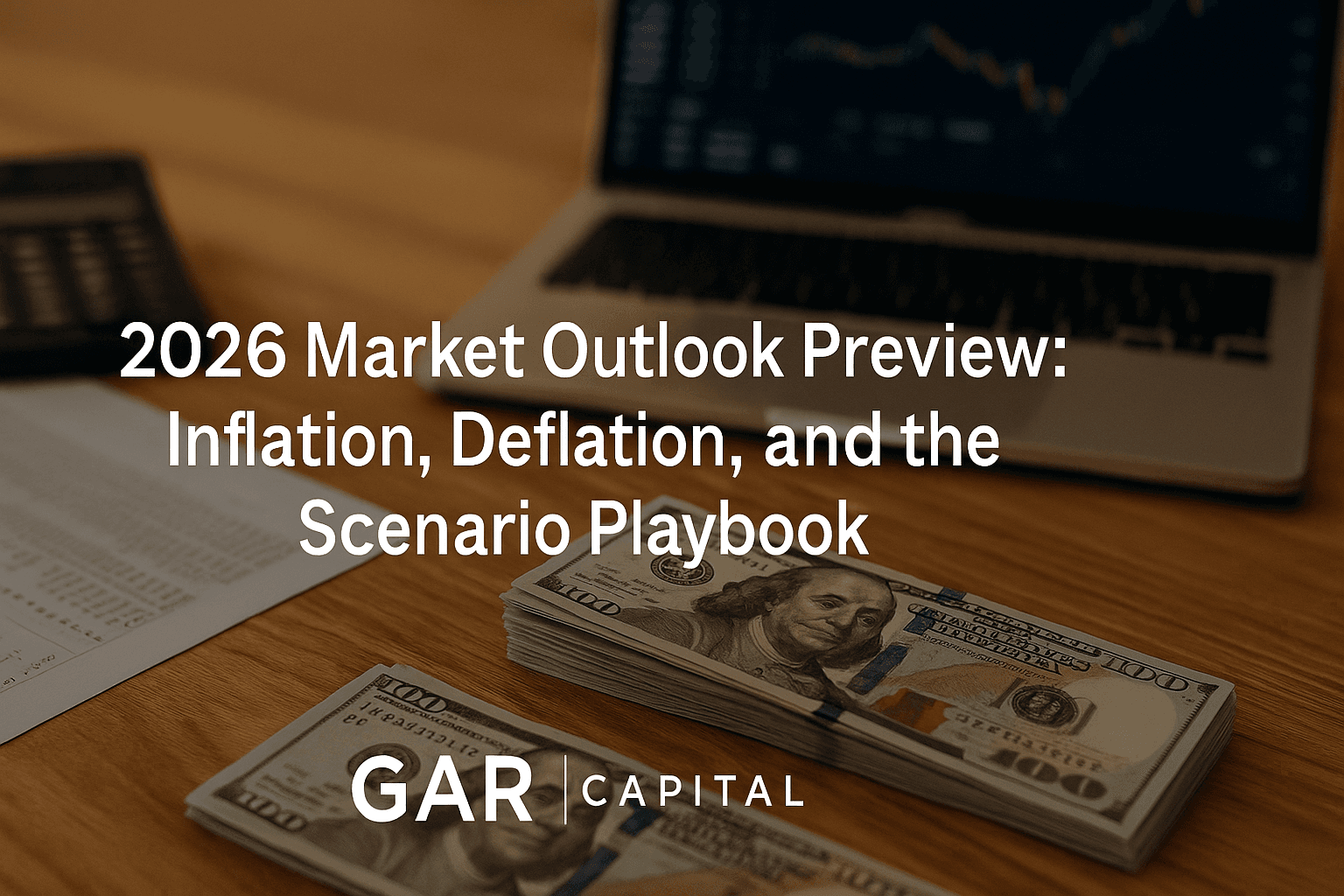Summary
This 2026 market outlook note explores the two dominant macro forces likely to define next year: inflation or deflation. By examining historical analogs like 2022 and 2009–2010, the framework outlines how each scenario influences sector leadership, risk appetite, and asset allocation. With the S&P 500 hovering near its 50-day moving average and year-end still wide open, the focus shifts from prediction to preparation—mapping playbooks, monitoring signals, and positioning intelligently for both paths.
Market Movers
- 📈 FOMC Meeting Minutes: Nov 19, 2025
- 📈 Non-Farm Employment Change: Nov 20, 2025
- 📈 Flash Manufacturing PMI: Nov 21, 2025
📚 Deep Dive 📚
2026 Preview: What I’m Watching, Possible Scenarios & How I’m Beginning to Build a Game Plan
GAR Capital Research — Market Outlook Note
As I write this, it’s Monday, pre-NVDA earnings, and price action continues to chop around with no real conviction from either side. It feels like a good moment to zoom out, reset the lens, and start building a framework for 2026 positioning — not with predictions, but with probabilities and preparation.
For context, the S&P 500 is currently sitting right at its 50-day moving average around 6,725, which may end up being either a key springboard or the start of a deeper reset depending on what unfolds into year-end.
I keep coming back to one simple but critical question:
What is more likely to define 2026 — inflation or deflation?
This isn’t just academic. The answer determines sector leadership, asset allocation, risk posture, and how aggressive or defensive we want to be when the new year begins. Let’s break down both sides.
Scenario 1: Inflation Re-Accelerates
A reasonable analog here is 2022 — the post-2021 boom unwind that saw growth, tech, and crypto sell off hard while the broader economy endured two consecutive quarters of negative GDP growth.
What worked in 2022?
- Energy was the standout winner (and the only major sector green on the year)
- Utilities came next
- Healthcare held up relatively well even though it ended slightly red
If we see renewed inflation, especially if confirmed through delayed economic data due to the recent government shutdown (inflation prints, retail sales, jobs, unemployment, etc.), then the leadership map looks similar:
2026 Inflation Playbook
- Own cash-flow-rich, dividend-paying energy companies
- Favor defensive yield & pricing-power sectors (Utilities + Select Healthcare)
- Reduce exposure to crowded 2025 tech winners, waiting for re-entry on value rather than momentum
Energy works in inflation because it’s not optional spending and enjoys pricing power + cash flow + dividends, which create a cushion when growth stocks compress.
Scenario 2: Deflation Arrives First
If deflation takes the front seat, energy becomes a tougher trade because it relies directly on supply, demand, and real economic activity. A more relevant analog becomes 2009–2010, where markets drifted sideways, driven almost entirely by lower rates, a falling dollar, and easy liquidity rather than strong earnings growth.
2026 Deflation Playbook
- Tech regains leadership due to lower rates + cheaper capital + larger capex runway
- AI remains a growth engine because it’s not consumer-dependent
- Avoid sectors with unit-demand sensitivity (autos, discretionary tied to income elasticity)
In other words, deflation is tailwind fuel for companies that scale through capex + efficiency, not consumer volume.
Where We Stand Now
We still have roughly six weeks left before the year closes, and two very different paths are still on the table:
1️⃣ If we get a 10% correction from the highs → valuations reset, and 2026 starts with fresh opportunity and better entry points.
2️⃣ If we rally into year-end (classic Santa Rally) → valuations stretch further, and without a clear rate-cut commitment, it becomes harder to justify new upside, especially heading into a midterm election cycle, which historically carries lower forward returns due to perceived political gridlock.
My Working Conclusion (For Now)
2026 doesn’t require a perfect prediction — it requires readiness.
Right now, I am:
- Tracking inflation vs deflation signals weekly
- Prioritizing quality, balance sheet strength, and cash flow
- Mapping sector leaders for both environments so we can rotate with conviction
- Expecting volatility spikes around data releases + policy shifts
- Treating early 2026 as a positioning phase, not an all-in moment
If 2025 taught us anything, it’s that price can move faster than the narrative, but fundamentals always catch up.
More updates will follow as data improves — this is just the beginning of the thought framework.
Stay nimble, stay curious, and stay prepared.
— GAR Capital
🔥 Black Friday Deal Is LIVE — Don’t Miss Out
This is the biggest sale of the year at GAR Capital — and it’s the perfect time to level up your trading for 2026.
50% OFF all memberships: Monthly, Annual & Lifetime Legacy
Options + Futures now combined into one powerful package
Masterclass with Carlos G. 1-on-1 coaching + Lifetime Membership
If you’ve been waiting to join our community, get real-time alerts, weekly prep, live radio trading, and full access to our educational ecosystem…



